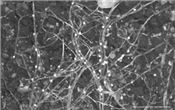|
Management Of Soybean Cyst Nematode Starts With Soil Sampling

Figure 1. Females of the soybean cyst nematode (white to yellow-colored, oval shaped objects attached to roots)
infecting soybean roots.
Photo: Dr. Greg Tylka, Iowa State University
DR. CARL A. BRADLEY
PRINCETON, KY.
Soybean cyst nematode (SCN) (Figure 1) causes greater annual yield losses in Kentucky than any other pathogen of soybean. The last time a formal survey was conducted by the University of Kentucky in 2006 and 2007, approximately 76 percent of soybean fields in the state were infested with SCN. Preliminary results from a new on-going SCN survey initiated in 2019 show that 84 percent of Kentucky fields are infested with SCN. Although above-ground symptoms (stunting and yellowing) caused by SCN can occasionally be observed, affected soybean plants generally appear to be healthy. Unfortunately, “healthy-looking” soybean plants that are infected by SCN can still have a 30 percent yield reduction.
Management of SCN has gotten much more complex in the last few years, since SCN populations have adapted to the use of SCN-resistant soybean varieties. The primary source of SCN resistance used by commercial soybean breeding programs came from a soybean germplasm line known as “PI 88788”. This source of resistance was highly effective in managing SCN for several years, but prolific use of soybean varieties with the PI 88788 background has selected for SCN populations that are able to overcome this source of resistance. In the 2006-2007 University of Kentucky SCN survey, the PI 88788 source of SCN resistance was not very effective against approximately 60 percent of the SCN populations in Kentucky, making management of this pathogen much more complex than before.
As complex as it is, management of SCN is still doable and is important for maintaining and increasing soybean yields. Below are the main steps for managing SCN:
Test fields to know the number of SCN eggs in your fields. The best times to sample for SCN in your fields is in fall or in spring (before planting). A fact sheet on sampling for SCN is available. Although the University of Kentucky does not currently have an active SCN Laboratory, samples can be sent to either the University of Illinois Plant Clinic or the University of Missouri SCN Diagnostics Lab. This Spring, the Kentucky Soybean Board is sponsoring free SCN testing for Kentucky farmers. With this program, a limited number of samples for each county can be tested for free. Please check with your local County Extension Office for more information about the limited free SCN testing program.
Rotate resistant varieties. If varieties are available that utilize sources of SCN resistance other than PI 88788 (such as Peking or Hartwig), then rotate the source of resistance every time you plant soybean in a field. Unfortunately, most of the soybean varieties adapted for planting in Kentucky utilize only the PI 88788 source of resistance. However, it is still important to rotate to different resistant soybean varieties, even though they are utilizing the same source of resistance. SCN is good at adaptation, so switching soybean varieties will help.
Rotate to non-host crops. Rotating fields to a non-host crop, such as corn or grain sorghum, will help reduce SCN populations in a fields. Wheat is another non-host crop that may help lower SCN populations by having it in the rotation. Several years ago, Dr. Don Hershman with the University of Kentucky evaluated the effect of wheat residue on SCN populations. His research found that planting soybeans into fields with standing wheat stubble reduced SCN populations at the end of the growing season. More information about that research can be found.
Consider using a nematode-protectant seed treatment. Several nematode-protectant seed treatment products are now available on the market. Although the effects of these seed treatments have not always been consistent in field research trials, they are additional tools that can be used along with resistant varieties to help manage this important pathogen.
A multi-state initiative funded by the Soybean Checkoff Program known as the SCN Coalition began recently. The primary purpose of the SCN Coalition is to help promote awareness of the damage caused by SCN and the importance in managing this pathogen. More information about the SCN Coalition is available on their website. Be on the lookout for information from the SCN Coalition about this important pathogen. ∆
DR. CARL A. BRADLEY: Extension Plant Pathologist, University of Kentucky
|
|